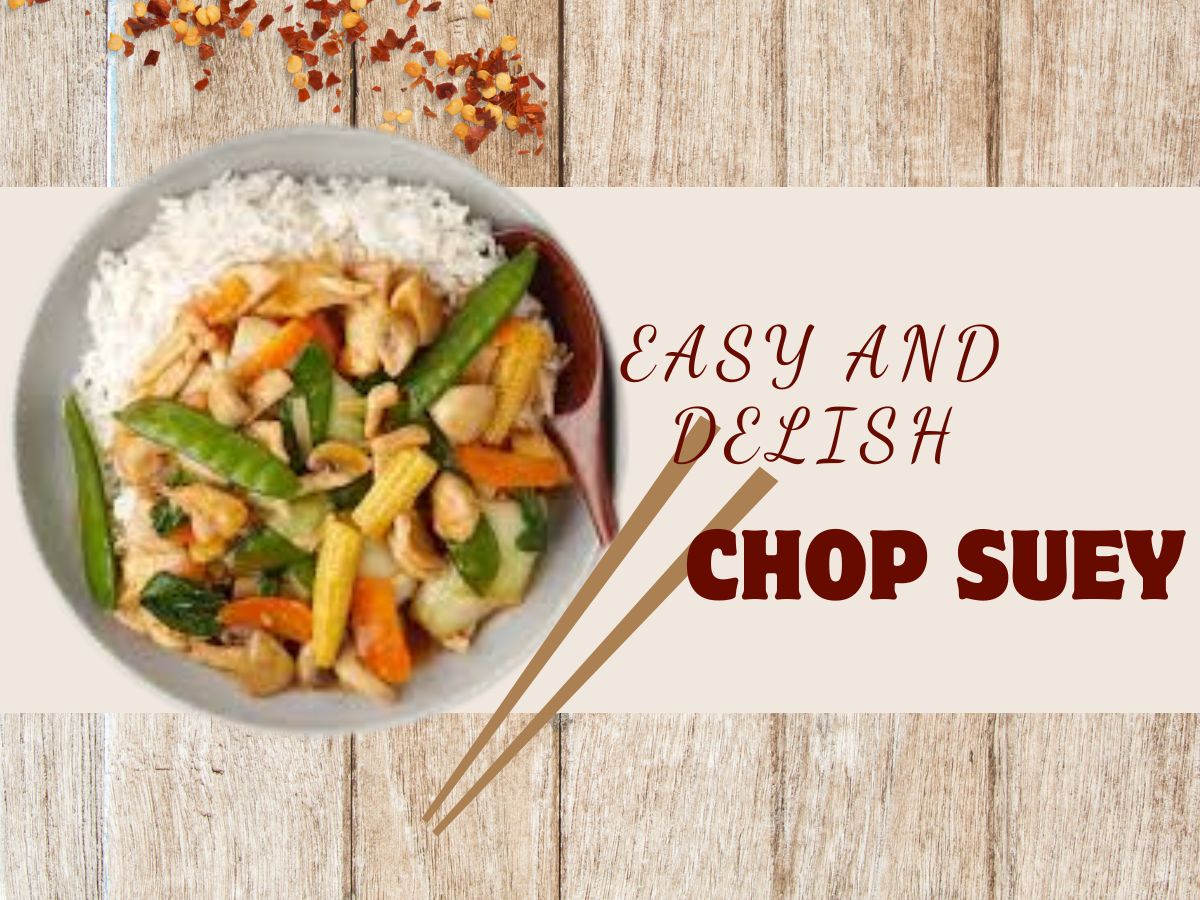Chop suey is a beloved Chinese-American dish that showcases the perfect harmony of fresh vegetables, tender protein, and savory sauce served over steamed rice. This classic stir-fry has been a staple in American Chinese restaurants for over a century, winning hearts with its colorful presentation, satisfying flavors, and wholesome combination of ingredients.
The beauty of chop suey lies in its versatility and the abundance of crisp vegetables that make every bite both nutritious and delicious. Unlike many heavy dishes, chop suey celebrates the natural flavors of fresh ingredients while bringing them together with a light, flavorful sauce that doesn’t overpower the individual components.
Whether you’re looking to recreate your favorite restaurant experience at home or want to master this timeless dish for family dinners, this comprehensive guide will teach you everything you need to know about making authentic chop suey. From selecting the freshest vegetables to achieving the perfect sauce consistency, you’ll discover the secrets that make this dish truly special.
Recipe Overview
| Prep Time | 25 min |
| Cook Time | 15 min |
| Total Time | 40 min |
| Serving Size | 4-6 people |
| Difficulty Level | Easy |
| Cuisine | Chinese-American |
Essential Chop Suey Ingredients
For the Base:
- 4-6 cups cooked steamed rice (jasmine or long-grain white rice)
- 1 pound protein of choice (chicken, pork, beef, or shrimp)
- 2 tablespoons vegetable oil for cooking
- 2 cloves garlic, minced
- 1 tablespoon fresh ginger, minced
Chop Suey Vegetables:
- 2 cups fresh bean sprouts
- 1 cup celery, sliced diagonally
- 1 medium onion, sliced
- 1 bell pepper, cut into strips
- 8 oz mushrooms, sliced (button or shiitake)
- 1/2 cup bamboo shoots, sliced
- 1/2 cup water chestnuts, sliced
- 2 cups bok choy or napa cabbage, chopped
- 2 green onions, chopped for garnish
Chop Suey Sauce:
- 1 cup chicken or vegetable broth
- 3 tablespoons soy sauce
- 1 tablespoon oyster sauce
- 1 teaspoon sugar
- 1/2 teaspoon white pepper
- 2 tablespoons cornstarch
- 3 tablespoons cold water
- 1 teaspoon sesame oil
Optional Additions:
- 1/2 cup snow peas
- 1/2 cup sliced carrots
- 1/4 cup cashews or almonds
- 1 tablespoon rice wine or dry sherry

Step-by-Step Chop Suey Procedure
Step 1: Prepare the Rice
- Cook rice according to package directions (about 3 cups raw rice for 4-6 servings)
- Keep rice warm in a covered pot or rice cooker
- Fluff with a fork just before serving
Step 2: Prepare the Sauce
- In a medium bowl, whisk together broth, soy sauce, oyster sauce, sugar, and white pepper
- In a small, separate bowl, mix cornstarch with cold water to create a smooth slurry
- Set both mixtures aside until ready to use
Step 3: Prepare All Ingredients
- Cut protein into bite-sized pieces (about 1-inch cubes)
- Wash and prepare all vegetables, cutting them into uniform sizes
- Arrange vegetables in order of cooking time needed
- Have all ingredients within easy reach of the stove
Step 4: Cook the Protein
- Heat 1 tablespoon of oil in a large wok or skillet over high heat
- Add protein pieces and stir-fry until cooked through (4-6 minutes)
- Remove protein from the wok and set aside on a plate
- Don’t clean the wok – you want to keep those flavorful bits
Step 5: Stir-Fry the Aromatics
- Add the remaining oil to the same wok
- Add minced garlic and ginger, stir-fry for 30 seconds until fragrant
- Be careful not to burn the garlic
Step 6: Cook Vegetables in Stages
- Add onions first, stir-fry for 2 minutes
- Add celery and bell peppers, cook for 2 minutes
- Add mushrooms and cook for 2 minutes
- Add bamboo shoots and water chestnuts, cook for 1 minute
- Add bok choy or cabbage, cook for 1 minute
- Finally, add bean sprouts, stir-fry for 1 minute
Step 7: Combine and Finish
- Return cooked protein to the wok with vegetables
- Pour the prepared sauce mixture over everything
- Stir constantly while bringing to a boil
- Add the cornstarch slurry gradually while stirring
- Cook for 2-3 minutes until the sauce thickens and coats the ingredients
- Drizzle with sesame oil and stir once more
Step 8: Serve Immediately
- Serve hot chop suey over individual portions of steamed rice
- Garnish with chopped green onions
- Provide extra soy sauce on the side if desired
Preparation and Serving Guide
Preparation Tips:
- Prep everything first: Have all vegetables cut and sauces mixed before cooking
- Uniform cuts: Cut vegetables into similar sizes for even cooking
- Fresh ingredients: Use the freshest vegetables possible for the best crunch and flavor
- Room temperature protein: Let the protein sit out for 10 minutes before cooking
Serving Suggestions:
- Individual servings: Serve 1 cup of rice topped with 1 cup of chop suey mixture
- Family style: Place rice in a large bowl, chop suey in a serving dish
- Garnish options: Sesame seeds, sliced almonds, or crispy wonton strips
- Side dishes: Egg rolls, pot stickers, or hot and sour soup
Presentation Ideas:
- Colorful arrangement: Arrange vegetables to showcase different colors
- Sauce on the side: Serve extra sauce in small bowls for individual preference
- Fresh herbs: Garnish with fresh cilantro or Thai basil
- Texture contrast: Add toasted nuts or seeds for crunch
Nutritional Guide
| Calories | 320 kcal |
| Protein | 24 g |
| Carbohydrates | 38 g |
| Fat | 8 g |
| Fiber | 6 g |
| Sugar | 9 g |
| Sodium | 680 mg |
| *Per Serving (based on 6 servings with chicken) | |
Health Benefits:
- High vegetable content: Provides vitamins A, C, and K
- Lean protein: Supports muscle health and satiety
- Low-fat: Heart-healthy cooking method
- Fiber-rich: Promotes digestive health
- Antioxidants: From colorful vegetables
Making It Healthier:
- Use brown rice instead of white rice for more fiber
- Increase the vegetable ratio to the protein ratio
- Use low-sodium soy sauce and broth
- Add more colorful vegetables like red bell peppers and carrots
- Use minimal oil for stir-frying
Temperature and Storage Guide
Cooking Temperatures:
- Wok temperature: Medium-high to high heat (375-400°F/190-200°C)
- Internal protein temp: 165°F (74°C) for chicken, 145°F (63°C) for beef
- Serving temperature: Serve immediately while hot
Storage Guidelines:
- Refrigerator: Store leftovers in airtight containers for up to 4 days
- Freezer: Can freeze for up to 3 months (vegetables may soften)
- Reheating: Best reheated in a wok or large skillet with a splash of broth
- Rice storage: Store rice separately from the chop suey mixture
Food Safety:
- Cool quickly: Refrigerate within 2 hours of cooking
- Reheat thoroughly: Heat to 165°F (74°C) when reheating leftovers
- Fresh vegetables: Use fresh bean sprouts within 2-3 days
- Separate storage: Keep rice and chop suey mixture in separate containers
Professional Tips and Tricks
Vegetable Tips:
- Blanch hard vegetables: Pre-blanch carrots or broccoli if using
- Bean sprout freshness: Look for crisp, white bean sprouts without brown spots
- Celery preparation: Cut on the diagonal for better appearance and cooking
- Mushroom moisture: Pat mushrooms dry before cooking to prevent a soggy texture
Sauce Tips:
- Taste and adjust: Season gradually and taste as you go
- Smooth sauce: Whisk cornstarch slurry thoroughly to prevent lumps
- Sauce consistency: Add more broth if too thick, more cornstarch slurry if too thin
- Balance flavors: Aim for a balance of salty, sweet, and umami
Cooking Technique Tips:
- High heat control: Keep the heat high, but don’t let the vegetables burn
- Constant motion: Keep ingredients moving in the wok
- Don’t overcrowd: Cook in batches if making large quantities
- Timing is key: Have everything ready before you start cooking
Professional Secrets:
- Wok hei: The “breath of the wok” comes from proper high-heat technique
- Velvet the protein: Marinate the protein in egg white and cornstarch for tenderness
- Reserve pasta water: Save some cooking liquid to adjust the sauce consistency
- Finish with acid: A splash of rice vinegar brightens the final dish
Alternative Chop Suey Recipes
Chicken Chop Suey
Protein Preparation:
- 1 pound boneless chicken thighs or breasts, cubed
- Marinate in 1 tablespoon soy sauce and 1 teaspoon cornstarch for 15 minutes
- Cook until golden brown and cooked through
Pork Chop Suey
Pork Options:
- Use pork tenderloin or pork shoulder, cut into thin strips
- Marinate with 1 tablespoon rice wine and 1 teaspoon sugar
- Cook quickly over high heat to keep tender
Beef Chop Suey
Beef Selection:
- Use flank steak or sirloin, sliced against the grain
- Marinate in a soy sauce and cornstarch mixture
- Cook briefly to maintain tenderness
Shrimp Chop Suey
Shrimp Preparation:
- 1 pound large shrimp, peeled and deveined
- Season with salt and white pepper
- Cook for 2-3 minutes until pink and curled
Vegetarian Chop Suey
Plant-Based Options:
- Replace protein with extra-firm tofu, cubed and pan-fried
- Add more mushroom varieties for umami depth
- Include protein-rich vegetables like edamame
- Use vegetable broth instead of chicken broth
Seafood Chop Suey
Mixed Seafood:
- Combine shrimp, scallops, and firm white fish
- Add seafood in order of cooking time needed
- Finish with a squeeze of fresh lemon juice
Alternative Cooking Techniques
Steam-and-Stir Method
- Steam harder vegetables (carrots, broccoli) for 3-4 minutes first
- Then stir-fry with other ingredients
- This ensures even cooking of all vegetables
Two-Wok Method
- Use one wok for protein and aromatics
- Use the second wok for vegetables
- Combine both with the sauce at the end
- Professional kitchens often use this method
Slow Cooker Chop Suey
- Brown the protein in a skillet first
- Add all ingredients except bean sprouts to the slow cooker
- Cook on low for 4-6 hours
- Add bean sprouts and cornstarch slurry in the final 30 minutes
Oven Method
- Preheat oven to 425°F (220°C)
- Toss all ingredients with the sauce in a large roasting pan
- Roast for 15-20 minutes, stirring halfway through
- Add cornstarch slurry and roast 5 more minutes
Understanding Chop Suey Origins and Variations
Historical Background:
Chop suey originated in Chinese-American communities in the late 1800s as a way to create satisfying meals using available American ingredients combined with traditional Chinese cooking techniques.
Regional Variations:
- American chop suey: Often includes ground beef and elbow macaroni
- Filipino chop suey: Features quail eggs and different vegetable combinations
- Canadian chop suey: Sometimes includes French fries as a base
Restaurant vs. Home Style:
- Restaurant style: Often more sauce, served very hot
- Home style: More vegetables, lighter sauce, customizable ingredients
Frequently Asked Questions
What is chop suey made of?
Chop suey is made of a mixture of stir-fried vegetables (typically including bean sprouts, celery, onions, and mushrooms), protein (chicken, pork, beef, or seafood), and a light, savory sauce, all served over steamed rice. The vegetables remain crisp-tender, and the dish is known for its fresh, clean flavors.
What does chop suey consist of?
Traditional chop suey consists of bean sprouts, celery, onions, mushrooms, bamboo shoots, and water chestnuts, stir-fried with your choice of protein in a light sauce made from broth, soy sauce, and cornstarch. It’s always served over steamed rice and focuses on showcasing fresh vegetable flavors.
Is chop suey healthy?
Yes, chop suey is generally considered a healthy dish because it’s packed with fresh vegetables, contains lean protein, and uses minimal oil in preparation. It’s high in fiber, vitamins, and minerals while being relatively low in calories and fat compared to many other Chinese-American dishes.
What’s the difference between chop suey and chow mein?
The main difference is that chop suey is served over steamed rice and features more vegetables in a saucy stir-fry, while chow mein uses stir-fried noodles as the base with less sauce. Chop suey has a wetter consistency and focuses more on the vegetable medley.
Can I make chop suey without meat?
Absolutely! Vegetarian chop suey is delicious and authentic. You can use tofu, tempeh, or increase the variety and quantity of vegetables. Add protein-rich ingredients like cashews or edamame for a more filling meal.
Why are my vegetables soggy in chop suey?
Soggy vegetables usually result from overcooking or cooking at too low a heat. Use high heat, don’t overcrowd the pan, and add vegetables in stages based on their cooking times. Bean sprouts should be added last and cooked for only 1-2 minutes.
What type of rice is best for chop suey?
Long-grain white rice, like jasmine rice, works best because it stays fluffy and doesn’t clump together. The individual grains provide a good base for the saucy chop suey mixture. Brown rice is a healthy alternative that also works well.
Can I prepare chop suey ahead of time?
While chop suey is best served fresh, you can prep ingredients ahead of time. Cut vegetables and prepare the sauce up to a day in advance, but cook everything together just before serving to maintain the best texture and flavor.
How do I thicken chop suey sauce?
Mix cornstarch with cold water to create a slurry, then add it gradually to the simmering chop suey while stirring constantly. The sauce will thicken within 2-3 minutes. Start with less and add more if needed – you can always make it thicker, but it’s harder to thin it out.
What vegetables are essential for authentic chop suey?
Bean sprouts, celery, and onions are the most traditional vegetables in chop suey. Mushrooms, bamboo shoots, and water chestnuts are also common. The key is using fresh, crisp vegetables that maintain some texture after cooking.
Conclusion
Chop suey represents the beautiful fusion of Chinese cooking techniques with American ingredients and preferences, creating a dish that’s both nutritious and deeply satisfying. This versatile stir-fry celebrates the natural flavors of fresh vegetables while providing a complete, balanced meal that’s perfect for any occasion.
The key to exceptional chop suey lies in understanding the balance between fresh, crisp vegetables, properly cooked protein, and a light sauce that enhances rather than masks the individual ingredients. With practice, you’ll develop an intuitive sense for timing and heat control that will make your homemade chop suey rival any restaurant version.
Whether you’re cooking for a busy weeknight dinner, meal prepping for the week, or entertaining guests, chop suey offers endless possibilities for customization while maintaining its essential character. From protein choices to seasonal vegetable variations, this dish adapts beautifully to your preferences and dietary needs.
Remember that the best chop suey starts with the freshest ingredients and proper technique. Don’t rush the cooking process, and always taste and adjust seasonings as you go. With the comprehensive guide, tips, and variations provided here, you’re well-equipped to master this timeless dish and make it a regular part of your cooking repertoire.
Enjoy exploring the wonderful world of chop suey, and don’t be afraid to make it your own by experimenting with different vegetables, proteins, and flavor combinations. The foundation techniques will serve you well as you develop your personal version of this classic Chinese-American dish.









